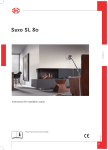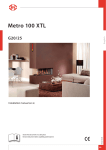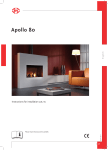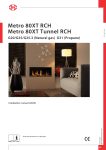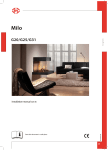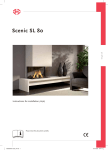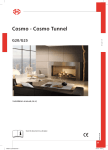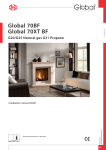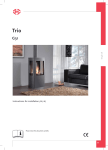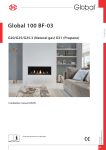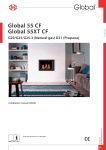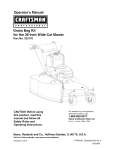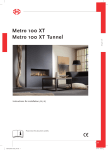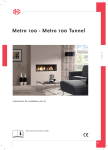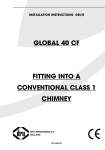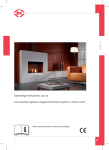Download Installation manual
Transcript
English ScenicSL80 Instructionsforinstallation(GB/IE) 959.008.03.uK Pleaseretainthisdocumentcarefully UK scenic sl 80 - i n s t r u c t i o n f o r i n s ta l l at i o n Contents English Preface 1.Introduction 2.CE declaration 3.SAFETY 3.1 General 3.2 Regulations 3.3 Precautions / safety instructions during installation 4.Instructions 5.Removing the packaging 6.Installation 6.1 Regulations 6.2 Type of gas 6.3 Gas connection 6.4 Placing the appliance 6.5 Flue gas discharge / combustion air supply system 6.6 Placing the chimney breast 6.7 Placing the control box 6.8 Adjusting the appliance 6.9 Placing wood set 6.10 Panes 7.Wireless remote control 7.1 Receiver 8.Final check 8.1 Gastightness 8.2 Gas pressure / pre-pressure 8.3 Ignition pilot burner and main burners 8.4 Flame image 9.Maintenance 10.Delivery 11.Malfunctions Appendix 1Parts included with the delivery Appendix 2Technical data Appendix 3Parts page 2 3 3 3 3 3 3 4 4 4 4 4 4 5 7 10 12 13 14 19 20 20 21 21 21 21 22 23 23 24 26 26 26 Preface DRU, a manufacturer of gas heating appliances, develops and produces products that comply with the highest quality, performance and safety requirements. This guarantees that the user will be able to enjoy using his product for many years to come. This appliance has a CE marking, which means that it complies with the essential requirements of the European gas appliance directive. As an installer, you must be competent in the field of atmospheric gas heating. Two manuals are supplied with the appliance: the installation manual and the user manual. The installation manual will give you the information you need to install the appliance in such a way that it will operate properly and safely. This manual discusses the installation of the appliance and the regulations that apply to the installation. In addition, you will find technical data for the appliance and information on maintenance, any malfunctions that might occur and their possible causes. Please carefully read and use this installation manual. The following symbols are used in the manual to indicate important information: ➠Work to be performed !TipSuggestions and recommendations !CautionYou will need these instructions to prevent problems that might occur during installation and/or use. CautionYou need these instructions to prevent fire, personal injury or other serious damages. After delivery, you should give the user manual and this installation manual to the user. UK 2 scenic sl 1. 80 - i n s t r u c t i o n f o r i n s ta l l at i o n Introduction The Scenic SL 80 is a closed atmospheric gas heating appliance. The appliance is suitable for natural gas. The safe operation of the appliance is guaranteed by the use of a second thermocouple fitted to the main burner A closed appliance does not extract the combustion air from the living environment, but from outside. This is done through a combined flue gas discharge system / combustion air supply system. In this concentric system the outer pipe serves as air supply and the inner pipe as flue gas discharge. This system can be installed through the wall, or through the roof. The Scenic SL 80 will be built within a chimney breast. For this, DRU has a number of chimney breasts in its programme. The chimney breast must be ventilated, for a proper heat discharge. DRU is able to supply various ventilation elements. The appliance is supplied with a wireless remote control that works on batteries. 2. CE declaration English We hereby declare that the design and construction of DRU’s atmospheric gas heating appliance comply with the essential requirements of the Gas Appliance Directive. Product:atmospheric gas heating appliance Type: Scenic SL 80 Applicable EEC directives: 90/396/EEC Applied harmonized standards: NEN-EN-613 NEN-EN-613/A1 Internal measures by the company guarantee that appliances produced in series comply with the essential requirements of the prevailing EEC directives and the standards derived from them. This declaration will lose its validity if adjustments are made to the appliance, without prior written permission by DRU. M.J.M. Gelten General manager DRU verwarming B.V. Postbus 1021, 6920 BA Duiven Ratio 8, 6921 RW Duiven www.dru.nl 3. SAFETY 3.1 General Caution -Carefully read this chapter on safety, before you start performing installation or maintenance work -Please observe the general regulations and the precautions/safety instructions in this manual 3.2 Regulations Please install the appliance in accordance with the applicable national, local and constructional (installation) regulations. In the Netherlands, the Bouwbesluit applies. 3.3 Precautions / safety instructions during installation Carefully follow the following precautions/safety regulations: ➠you should only install and maintain the appliance if you are a competent installer in the field of atmospheric gas heating; ➠do not make any changes to the appliance; ➠use incombustible and heat resistant material for building the chimney breast, including the back wall, the inside and the top of the chimney breast; ➠comply with the minimum required internal measurements of the chimney breast; ➠ventilate the chimney breast by means of the ventilation holes, which will form a combined passage of at least 200 cm2; ➠only use the flue gas discharge / combustion air supply system supplied by DRU; ➠mount the appliance using the wall brackets supplied; ➠do not place the appliance too tightly against the back wall; ➠make sure the space between the appliance’s legs is kept free; 3 uk scenic sl 80 - i n s t r u c t i o n f o r i n s ta l l at i o n ➠do not cover the appliance and/or do not wrap it in an insulation blanket or any other material; ➠make sure that combustible objects and/or materials have a distance from the appliance of at least 500 mm; ➠ make sure thermocouple 2 and the space around it are kept free; ➠only ever use the supplied wood set; ➠place the wood set exactly as described; ➠make sure the pilot burner and the space around it is kept free; ➠avoid dirt in gas pipes and connections; ➠mount a gas tap directly next to the appliance; ➠check the connections for gastightness before using the appliance; ➠use heat resistant electrical connectors; ➠place the electrical connections in such a way that they are free from the appliance; ➠avoid blocking of the pressure equalization hatch(es) on top of the appliance; ➠check whether the pressure equalization hatch(es) fit well onto the sealing surface, prior to building in the appliance; ➠replace torn or broken panes; ➠do not ignite the appliance until it is fully installed. English 4. Instructions Observe the following items during installation in order to guarantee a proper and safe operation of the appliance: ➠mount the control box supplied as low as possible; ➠avoid that the ignition cable runs over the receiver; ➠avoid that the ignition cable touches or crosses the antenna; ➠avoid that the ignition cable runs alongside metal parts, in order to prevent weakening of the spark; ➠properly finish the edges in case of a tight construction; ➠do not apply plaster on or over the flanges; ➠avoid damaging the panes during removal/placing; ➠clean the panes before you use the appliance, in order to prevent dirt from burning in the glass; ➠ make sure that the wires of thermocouple 2 cannot come into contact with hot parts. 5. Removing the packaging Note the following items when removing the packaging: ➠Check the appliance for damages during transport. ➠If necessary, contact DRU Service. After removing the packaging, you should have the following components: -Socket spanner; you will find it in the space between the assembly frame and the combustion chamber; -Decorative strips; you will find them in the abovementioned space as well; -Front pane; you will find it in the same box as the appliance - provided with protective corners; -Box containing parts; you will find it in the combustion chamber. ➠Remove the box containing parts from the combustion chamber. In appendix 1 / table 4 you can see which parts you should have after removing the packaging. ➠Contact DRU Service if you do not have all the parts after you finished removing the packaging. ➠Dispose packaging in accordance with local regulations. 6. Installation Read this manual carefully to ensure a proper and safe operation of the appliance. !CautionInstall the appliance in the order described in this chapter. 6.1 Regulations -Observe the applicable (installation) regulations. -Observe the regulations/instructions in this manual. 6.2 Type of gas The type plate indicates for which type of gas, gas pressure and for which country this appliance is intended. The type plate is connected to a chain. It should remain connected to the chain. CautionCheck whether the appliance is suitable for the type of gas and the gas pressure used at the location. 6.3 Gas connection Place a gas tap in the gas connection, close to the appliance. UK 4 scenic sl 80 - i n s t r u c t i o n f o r i n s ta l l at i o n Caution - Avoid dirt in the gas pipe and the connections; - Do not turn the gas tap when connecting the gas pipe. Thefollowingrequirementsapplytothegasconnection: - useagaspipewiththecorrectdimensions,sothatnopressurelosscanoccur; - thegastapshouldhavetheCEmarking; - youshouldalwaysbeabletoreachthegastap. 6.4Placingtheappliance Placetheapplianceasfollows: Caution - make sure that combustible objects and/or materials have a distance from the appliance of at least 500 mm; - Donotmakeanychangestotheappliance. !Caution - Take the build-in height of the appliance into account; it depends on the length of the adjustable legs (see fig. 1). Ifnecessary,thelegscanbeshortened.Theymustbefixedwithself-boringparkers(seefig. 2); - Takethedepthoftheapplianceintoaccount(seefig. 3);(498mmminimum). - - - - 160mmforawallductthroughincombustiblematerial; Ø Ø250mmforawallductthroughcombustiblematerial; Ø160mmforaroofductthroughincombustiblematerial; Ø250mmforaroofductthroughcombustiblematerial. Place the appliance on its destined location. 150 100 493,5 874 589 16 50 16 257 380 125 16 810 344 Max 1197 450 ➠ English Determine the location of the appliance. Provide a gas connection at the location. For details, see section 6.3. Make a duct for the flue gas discharge/combustion air supply system with the following diameters. For details, see section 6.5. Min 732 ➠ ➠ ➠ 38c-1257 Fig. 1 Scenic SL80 5 UK scenic sl 80 - i n s t r u c t i o n f o r i n s ta l l at i o n English 3 2 1 38c-1262 Fig. 2 Tot. min. 200cm 2 15 15 =7 25 = UK 6 459 7,5 100 250 90 8 100 1075 7,5 1080 454 15 Fig. 3 Tot. min. 200cm 2 =7 25 114 n. mi x. 177 ma = 100 250 108 8 399 0 38c-1264 49 08 n. 1 mi x. 177 ma scenic sl 80 - i n s t r u c t i o n f o r i n s ta l l at i o n Thegascontrolblockismountedundertheappliance,attheburnerplate.Itshouldbemadelooseandplacedinthecontrolboxatalaterstage. Forplacingthegascontrolblockinthecontrolbox,seesection6.7. Followtheproceduredescribedbelow: !Caution ➠ ➠ ➠ Caution ➠ ➠ !Caution ➠ ➠ ➠ Caution ➠ Disconnect the pipes of the gas control block (flexible gas pipe, aluminium pilot flame pipe and thermocouple 1). The red wire of thermocouple 2 must remain connected to the gas control. Fig. 3a shows how the wires are connected to the thermocouple. Disconnect the gas control block from the burner plate by unscrewing the parker. Carefully unwind the red and black wires of thermocouple 2. Lay the gas control together with the wires of thermocouple 2 in the direction of the control box. - Avoid dirt in the pipes; - Avoid kinks in the pipes. Roll out the pipes in the direction of the control box. Afb. 3a Roll out the ignition cable in the direction of the control box. The type plate should remain connected to the chain. Lay the chain with type plate in the direction of the control box. Set the height of the appliance and make the appliance level at the same time. - Do not place the appliance too tightly against the back wall; - Make sure the space between the appliance’s legs is kept free; - Do not cover the appliance and/or do not wrap it in an insulation blanket or any other material. Connect the appliance to the wall using the wall brackets and the wedge bolts supplied; see fig. 2. English ➠ 6.5Fluegasdischarge/combustionairsupplysystem 6.5.1General TheapplianceisoftheC11/C31type. Theapplianceisconnectedtoacombinedfluegasdischarge/combustionairsupplysystem,hereafterreferredto astheconcentricsystem. Thepassagetotheoutsidecanbemadewithawallduct(seesection6.5.2)oraroofduct(seesection6.5.3). Ifnecessary,youcanalsouseanexistingdischargechannel(seesection6.5.4). Caution Only use the concentric system supplied by DRU (Ø100 / Ø150 mm). This system has been tested together with the appliance. DRU cannot guarantee a proper and safe operation of other systems. - For connecting to an existing chimney flue you should only use the installation set supplied by DRU. Theconcentricsystemisconstructedfrom(thedischargestumpof)theappliance. Ifstructuralcircumstancesrequirethattheconcentricsystemisplacedfirst,theappliancecanlaterbeconnected withatelescopicpipepiece. 6.5.2Applicationwithwallduct 6.5.2.1Constructionofconcentricsystemwithwallduct Theconcentricsystemwithwallducthastocomplywiththefollowingconditions: - First,aconcentricpipeofatleast1metershouldbeconnectedverticallytotheappliance; - Thetotalverticalpipelengthcanhaveamaximumof4meters; - Aftertheverticalpartabendof90°isconnected; - Thetotalhorizontalpipelengthcanhaveamaximumof3meters(excludingthewallduct). Theconstructionoftheconcentricsystemallowsthefollowing2configurations: 1)minimum1meterandmaximum4metersofverticalpipelengthcombinedwitha90°bendandamaximum3 metershorizontalpipelengthandawallduct(seefig. 4a). Whenusingthisapplication,youmustremovetheairinletguides(seesection6.8).Thebafflewillnotbeplaced. 2)minimum1meterandmaximum4metersofverticalpipelengthcombinedwitha90°bendandawallduct(i.e., nohorizontalpart,seefig. 4b). Whenusingthisconfiguration,youwillnothavetodoanything:theairinletguidesdonothavetoberemoved;the baffledoesnothavetobeplaced. 7 UK scenic sl Afb. 4a 80 - i n s t r u c t i o n f o r i n s ta l l at i o n Afb. 4b 6.5.2.2Placingconcentricsystemwithwallduct Placetheconcentricsystemasfollows: English Caution - Maintain a distance of at least 50 mm between the outside of the concentric system and the walls and/or the ceiling. If the system is built in (for instance) a cove, it should be made with incombustible material all around it. - Use heat-resistant isolation material when passing through combustible material; - The rosette (mounting inner plate) of the wall duct is too small to seal the Ø 250 mm opening when passing through combustible material. That is why you should first apply a sufficiently large heat-resistant intermediate plate to the wall. Then, the rosette is mounted on the intermediate plate. !Caution Some heat-resistant isolation materials contain volatile components that will spread an unpleasant smell for a prolonged time; these are not suitable. Build the system up from (the connection stump of) the appliance. ➠ Connect the concentric pipe pieces and the bends. ➠ On each connection, apply a clip binding with silicon sealing ring. ➠ Use a parker to fix the clip binding to the pipe on locations that cannot be reached after installation. ➠ Apply sufficient clamps, so that the weight of the pipes does not only rest on the appliance. ➠ Determine the remaining length of the wall duct. ➠ Make sure the wall duct has the right dimensions. ➠ !Caution - Make sure that the right insertion length is maintained; - Place the wall duct with the groove/folded seam at the top; - Make sure the horizontal concentric pipe pieces are sloping towards the wall duct, in order to prevent rain water from entering. Mount the rosette (mounting inner plate); if necessary, on a heat resistant intermediate plate when passing through ➠ combustible material. Attach the wall duct from the outside with four screws in their respective holes. ➠ 6.5.3Applicationwithroofduct 6.5.3.1Constructionofconcentricsystemwithroofduct Theconcentricsystemwithroofducthastocomplywiththefollowingconditions - Theconstructionofthechosensystemhastobeallowed.(Seetheproceduredescribedbelow); - First,aconcentricpipeofatleast1metershouldbeconnectedverticallytotheappliance. Dependingontheconstructionoftheconcentricsystem,theapplianceissetbyplacingthebaffleand/orremoving theairinletguides. Inthefollowingprocedureyoucanseehowtheallowabilityofaconcentricsystemcanbedeterminedandwhich settingsareneeded. ➠ Determine the following data: 1)Thenumberofbendsrequired(nodistinctionismadebetween45°and90°bends); 2)Thetotalnumberofmetersofhorizontalpipelength; 3)Thetotalnumberofmetersofverticaland/orslopingpipelength(roofductexcluded). WiththesedataandTable1youwillbeabletodeterminewhethertheconcentricsystemisallowed. InTable2youcanseewhichsettingtheappliancerequires. Followtheproceduredescribedbelow: ➠ ➠ UK 8 In the first 2 columns of Table 1, look for the number of bends required and the total horizontal pipe length: In the 3rd column of Table 1, look for the total vertical and/or sloping pipe length. scenic sl 80 - i n s t r u c t i o n f o r i n s ta l l at i o n If you end up in a box with the letter A, B, C or D, the concentric system chosen by you is allowed. ➠Use Table 2 to determine which conditions apply for the baffle and/or the air inlet guides (for setting, see section 6.8). Examples To clarify, we will give 2 examples to determine the allowability of a concentric system and the conditions for setting the appliance. In Table 1 the route to be followed is indicated by arrows. The result is indicated by a box with a red frame. Example 1 1)2 bends 2)3 meters horizontal 3)8 meters vertical/sloping → Construction of this concentric system is allowed. → Situation B applies for setting the appliance. English Example 2 1)3 bends 2)4 meters horizontal 3)9 meters vertical/sloping → Construction of this concentric system is not allowed. Table 1: Conditions for setting appliance with roof duct G20 / G25 Total number of meters horizontal pipe length Total number of meters vertical and/or sloping pipe length 1 2 3 4 5 6 7 ↓8 ↓9 10 11 12 no bends 0 B B B B B C C C C D D D 2 bends 0 A A B B B B B C C C C D A A B B B B B C C C A A B B B B B C A A B B B B A A B B 1 2 → 3 4 5 3 bends 0 A 1 A A B B B B B C C C A A A B B B B B C C A A A B B B B B A A A B B B A A A B 2 3 → 4 C 5 4 bends 0 1 2 3 4 A A A A B B B B B C C A A A A B B B B B C A A A A B B B B A A A B B A A A A A C 5 5 bends - n= Situation is not allowed 9 uk scenic sl 80 - i n s t r u c t i o n f o r i n s ta l l at i o n Table 2: Situation Air inlet guides Baffle Distance restriction A NO NO OPEN B YES YES 47 mm C YES YES 37 mm D YES YES 32 mm 6.5.3.2 Placing concentric system with roof duct The roof duct can end in a sloping and a flat roof. The roof duct can be supplied with an adhesive plate for a flat roof or with a universally adjustable tile for a sloping roof. Place the concentric system as follows: English Caution-Maintain a distance of at least 50 mm between the outside of the concentric system and the walls and/or the ceiling. If the system is built in (for instance) a cove, it should be made with incombustible material all around it. -Use heat-resistant isolation material when passing through combustible material. !CautionSome heat-resistant isolation materials contain volatile components that will spread an unpleasant smell for a prolonged time; these are not suitable. ➠Build the system up from (the connection stump of) the appliance. ➠Connect the concentric pipe pieces and, if necessary, the bends. ➠On each connection, apply a clip binding with silicon sealing ring. ➠Use a parker to fix the clip binding to the pipe on locations that cannot be reached after installation. ➠Apply sufficient clamps, so that the weight of the pipes does not rest on the appliance. ➠Determine the remaining length of the roof duct. ➠Make sure the roof duct has the right dimensions. !CautionMake sure that the right insertion length is maintained. ➠Connect the roof duct to the concentric pipes. !Caution -Make sure that the universal tile fits well with the surrounding tiles; -Make sure that the adhesive plate fits well onto the flat roof. 6.5.4 Connection of existing chimney flue It is possible to connect the appliance to an existing channel. A flexible SS pipe is placed in the chimney for discharging flue gases. The surrounding space is used to supply combustion air. The following requirements apply when connecting to an existing chimney flue: -only allowed when used in combination with the special DRU chimney installation set. The installation regulation is also supplied. -the dimensions should be at least 150 x 150 mm; -the vertical length has a maximum of 12 meters; -the horizontal length has a maximum of 3 meters; -the existing chimney flue has to be clean; -the existing chimney flue has to be closed. For setting the appliance, the same conditions/instructions apply as for the concentric system described above. 6.6 Placing the chimney breast The appliance is designed to be mounted tightly in a new chimney breast. In order to provide proper heat discharge, there should be sufficient space around the appliance. The chimney breast should be ventilated sufficiently by means of ventilation holes. If the chimney breast is made of stone-like material, it is necessary to place a mantel iron (for this, see section 6.6.1). Caution-use incombustible and heat resistant material for building the chimney breast, including the back wall, inside and top of the chimney breast; -The ventilation holes - which should be mounted as high as possible - should have a combined passage of at least 200 cm2. !CautionWhen placing the chimney breast, you should take the following into account (see fig. 3): -the narrow flanges of the appliance’s mounting frame; U K 10 scenic sl 80 - i n s t r u c t i o n f o r i n s ta l l at i o n !Tip When using bricks, we recommend bricks with a thickness of 70 to 100 mm; - You should preferably apply the ventilation holes on both sides of the chimney breast: you can use DRU ventilation elements. ➠ ➠ ➠ Check whether the concentric system is placed correctly. Check the fixture of the clip binding with parkers on places that cannot be reached later on. Maintain sufficient space above the appliance in the chimney breast, so the heat can escape: - minimum internal height: ±1000 mm. Do not apply plaster on or over the flanges, because: - the heat of the appliance could cause cracks; - it will no longer be possible to remove/place panes. When using stone-like materials and/or plaster finishing, the chimney breast should dry for at least 6 weeks in order to prevent cracks. ➠ ➠ English - the location of the control box: it should be placed with a distance of 850 mm to the left or to the right of the appliance - as low as possible; - the measurements of the control box; see Placing the Control Box section 6.7; - the location of the ventilation holes; - the measurement of the panes, so that they can be placed/removed after placing the chimney breast; - the protection of the gas control block and the pipes against cement and plaster. 6.6.1Manteliron Amantelironmustbeplacedtopreventthattheappliancehastocarrytheweightofthestone-likematerialthatwas usedtobuildthechimneybreast(masonrychimneybreast). Below,youwillfindadescriptionofhowthemantelironshouldbemounted(seefig. 5a and 5b): ➠ ➠ Cut the mantel iron to the correct size. Place the mantel iron. Fig. 5a Fig. 5b 11 U K scenic sl 80 - i n s t r u c t i o n f o r i n s ta l l at i o n !Caution Do not allow the mantel iron to rest on the flanges of the build-in frame. Mount the threaded rods on the corners of the mantel iron (1), using the nuts. ➠ !Caution Adjust the threaded rod in such a way with the tensioning nut (2) that you have sufficient setting space. Determine the height of the eye (4). ➠ Mount the eye to the wall, using the wedge bolt. ➠ Mount the hook (3) of the threaded rod to the eye. ➠ Make it all level by using the tensioning screw. ➠ 6.7Placingthecontrolbox Thecontrolboxisplacedaslowaspossibleinthechimneybreast. Anumberofcomponentsareplacedinthecontrolbox,suchastypeplate,gascontrolblock,receiverbelongingto theremotecontrol. Proceedasfollows,whenplacingthecontrolbox;seefig. 6fordetails: Make an opening in the chimney breast of 285 x 194 mm (h x w). !Caution Take the position of the appliance’s legs into account. The shaded parts in fig. 3 show the locations where the control box can be mounted. Place the inner frame (1); unscrew bolts (5) for this. ➠ !Tip - When the chimney breast is made of bricks, the inner frame can be built with bricks at the same time; - When using a different material, you can glue the inner frame or fix it with four flush screws. Mount the gas control block to the brackets of the inner frame (2). ➠ Reconnect the pipes to the gas control block. ➠ English ➠ 1 4 6 5 Fig. 6 3 2 Fig. 7 37 38c-1383 Fig. 8 U K 12 Fig. 9 47 scenic sl Caution - 80 - i n s t r u c t i o n f o r i n s ta l l at i o n Avoid kinks in the pipes; Tighten the flexible hose and the aluminium pipe until they are gastight; First tighten thermocouple 1 by hand and then tighten it a quarter turn using a suitable spanner. ➠ ➠ ➠ ➠ ➠ ➠ ➠ If applicable, connect the wires of thermocouple 1 to the gas control block, see fig. 7; If necessary, blow through the gas pipe; Connect the gas pipe to the gas tap; Bleed the gas pipe; Place the receiver (3); for connections, see section 7.1; Place the type plate (6); Fix the outer frame with door (4) to the inner frame using 2 socket screws. !Tip You can place the outer frame in such a way, that the door turns to the left or to the right. 6.8Adjustingtheappliance English Theappliancehastobesetinsuchawaythatitworkscorrectlyincombinationwiththedischargesystem. Forthatpurpose,abaffleisplacedand/ortheairinletguidesareremoved.Theconditionsforusingawallductare describedinsection6.5.2.1,andforusingaroofductinsection6.5.3.1. Caution For Belgium, the condition applies that the primary aeration of the burners has to be changed, if the appliance is used with gas G25 instead of G20; see section. 6.8.1Baffle(R) Thebaffle(R)issuppliedseparately. Itismountedasfollows: ➠ ➠ ➠ Place the baffle. (see fig. 8) Use the template supplied to set the distance of the restriction (see fig. 9) as follows: - A distance of 32 mm means that the baffle is closed to a maximum level; - A distance of 37 and 47 mm is set by using a template. Fix the baffle by using the socket cap screw (U). 6.8.2Airinletguides(L) Theairinletguidesarelocatedatthebackoftheburners. Proceedasfollows,whenremoving;seefig. 10a and 10b: ➠ ➠ ➠ Take the tray surrounding the burners (M) out of the appliance. Remove the air inlet guides (L). Place the tray surrounding the burners (M), back in the appliance. Afb. 10a 13 U K English scenic sl 80 - i n s t r u c t i o n f o r i n s ta l l at i o n Afb. 10b 6.8.3Primaryaerationoftheburners Caution Adjusting the primary aeration only applies to appliances used in Belgium. Whenthetraysurroundingtheburnersisremoved,youcanseethethrottlerings(PaandPb)thataremountedon thepipesthatarefixedtotheburners(burnerpipes);seefig. 11. Theprimaryaerationoftheburnerscanbeadjustedbyrotatingthethrottlerings. Caution Rotate the throttle ring at the front left (Pb) with its opening towards the pilot flame burner. This throttle ring has only 1 hole with a diameter of 7 mm and 1 with a diameter of 13 mm (see fig. 11). Thestepstobetakenaredescribedbelow: ➠ ➠ ➠ Take the tray surrounding the burners (M) out of the appliance; see fig. 10a. Unscrew the socket cap screw (O) of a throttle ring (P), see fig. 11. Rotate the throttle ring (P) when using gas G25 in such a way, that the holes with the 7 mm diameter are directly opposite the 15 mm holes in the burner pipe; see fig. 11. Screw the socket cap screw (O) into the threaded hole above the 7 mm diameter hole. Repeat this procedure for the other 3 burner pipes. Return the tray surrounding the burners (M). ➠ ➠ ➠ Afb. 11 U K 14 scenic sl 80 - i n s t r u c t i o n f o r i n s ta l l at i o n Afb 12b Afb 12c Afb 12d English Afb 12a 6.9Placingwoodset Theapplianceissuppliedwithawoodset. Caution Strictly observe the following instructions to prevent unsafe situations: - only ever use the supplied wood set; - place the wood set exactly as described; - make sure the pilot burner and the space around it are kept free from objects (see fig. 12a and 12b); - make sure that thermocouple 2 and the space around it are kept free from objects (see fig. 12c and 12d); - make sure that the slot between the burner tray and the tray surrounding the burner is kept free from objects. 6.9.1Woodset Thewoodsetconsistsofvermiculite(seefig. 13),chips(seefig. 14)andanumberoflogs. ➠ Fill the burner tray with vermiculite; equally spread the vermiculite (see fig. 15). !Caution - You can influence the flame image by moving the vermiculite, yet - the burner deck has to remain covered with vermiculite in order to prevent that the life expectancy of the burner is reduced. Fill the tray around the burner with chips; equally spread the chips (see fig. 15); ➠ Identify logs A up to E by using fig. 16a. ➠ !Tip Use the burn stains on the logs for identification. ➠ ➠ Place log A up to E over the burners (see fig. 16b up to 16j); First place log A as indicated in fig. 16b. Caution - Make sure log A is lying correctly in relation to the ridge, see the arrow. Next, you should place log B; ➠ Caution Make sure log B is lying correctly in relation to the ridges. Proceed with logs C, D and E. ➠ Caution - The logs should be placed exactly as indicated in fig. 16j; - The logs should not completely cover the burner deck, because: 15 U K scenic sl English Afb 13 Afb. 15 Afb. 16a Afb. 16b U K 16 Afb 14 80 - i n s t r u c t i o n f o r i n s ta l l at i o n scenic sl 80 - i n s t r u c t i o n f o r i n s ta l l at i o n English Afb. 16c Afb. 16d Afb. 16e Afb. 16f 17 U K scenic sl English Afb. 16g Afb. 16h Afb. 16i Afb. 16j U K 18 80 - i n s t r u c t i o n f o r i n s ta l l at i o n scenic sl 80 - i n s t r u c t i o n f o r i n s ta l l at i o n - the main burner will not ignite properly; which could result in unsafe situations; - the appliance will become filthy more quickly, as a result of soot; - the flame image may be affected. 6.10Panes 6.10.1Frontpane Afterplacingthewoodsetyoucanplacethefrontpaneasdescribedbelow. !Caution Avoid damaging the front pane during removal/placing. 6.10.1.1Removingthefrontpane Whenremovingthefrontpane,youshouldfollowthenextsteps,seefig. 17a up to 17e: ➠ ➠ ➠ ➠ ➠ ➠ ➠ Remove the vertical decorative strips by pulling them off at the top first; turning them over parallel to the pane and then loosening them at the bottom. Remove the U-shape horizontal strip by gripping it with 2 hands in the slot and lifting it out. Unscrew the 5 parkers of the glass strip at the top by using the socket spanner supplied. Remove the top glass strip. Tilt the pane a little to the front at the top. Grab the pane at both sides. Lift up the pane and tilt it forward at the bottom. Remove the pane. English ➠ 6.10.1.2Placingthefrontpane Placingthefrontpanewilltakeplaceinreverseorderoftheremovalproceduredescribedabove. !Caution - The DRU logo should be at the bottom right corner; - Do not screw the parkers on too tight, to prevent breaking and/or slipping: tight=tight. - Avoid/remove fingerprints on the panes, as they will burn into the glass; - Make sure that the front pane fits well onto the side panes. Fig. 17a 6.10.2Sidepanes Thesidepanesshouldberemovedincaseoftorn orbrokenpanes. 6.10.2.1Removingthesidepane ➠ ➠ ➠ ➠ ➠ ➠ ➠ Remove the front pan, see section 6.10.1.1. above. Unscrew the parkers of the glass strips at the sides and the top by using the socket spanner supplied. Remove both glass strips. Tilt the pane a little to the front at the top. Grab the pane at both sides. Lift up the pane and tilt it forward at the bottom. Remove the pane. Fig. 17b 6.10.2.2Placingthesidepane Placingthesidepanewilltakeplaceinreverseorder oftheremovalproceduredescribedabove. !Caution - Do not screw the parkers on too tight, to prevent breaking and/or slipping: tight=tight. - Avoid/remove fingerprints on the panes, as they will burn into the glass. Fig. 17c 19 U K scenic sl English i n s t r u c t i o n f o r i n s ta l l at i o n Afb. 17e Afb. 17d 7. 80 - Wirelessremotecontrol Theapplianceissuppliedwithawirelessremotecontrol. Ignition,controllingtheflameheightandswitchingoffareperformedbyaremotecontrolthatoperatesareceiver inthecontrolbox. UserManual,chapter4,WirelessRemoteControl,describestheoperationoftheapplianceincludingthewaythe remotecontrolworks. Below,wewilldescribehowthereceiverisconnected. 7.1Receiver Thereceivershouldbeconnectedtotheappliance,beforethebatteriesareinstalled. Followtheprocedurebelow(seefig. 18): Slide the brown plug of the connecting cable onto the back of the receiver’s printed circuit board. Connect the white plug to the gas control block. !Tip The plugs have different sizes that correspond with the connectors. Connect the cables of thermocouple 1 to the receiver; (see fig. 18, arrow B and fig. 19). ➠ !Tip - The size of the eye corresponds with the size of the screw; - The colours of eye and screw also correspond. Connect the black wire with the white plug of thermocouple 2 to the receiver (see fig. 18, arrow E). ➠ !Caution Make sure that the wires of thermocouple 2 cannot come into contact with hot parts Connect the ignition cable to the receiver; (see fig. 18, arrow A and fig. 19). ➠ Connect power: ➠ a) When using batteries, see section 7.1.1 below; b) When using an adapter: - connect it to the receiver; (see fig. 18, arrow C); - insert the plug into the wall socket. ➠ ➠ ➠ ➠ ➠ Place the receiver in the control box, as indicated on fig. 19. Bend the antenna out of the clips; see fig. 18, arrow D and fig. 19. Set the antenna straight. !Caution - Do not place the antenna too close to the ignition cable and/or metal parts (for the correct position, see fig. 19); Do not place the ignition cable over and/or along metal parts: this will weaken the spark; Do not lay the ignition cable over the receiver. this could damage the receiver; Avoid dust on or in the receiver: cover it when performing work. 7.1.1Placing/replacingthebatteries Followtheprocedurebelowwhenplacingthebatteries: ➠ ➠ ➠ ➠ UK 20 Open the door of the control box. Pick up the receiver. Slide the cover off. Place or remove the 4 penlite (AA type) batteries. scenic sl 80 - i n s t r u c t i o n f o r i n s ta l l at i o n !Caution - Avoid a short circuit between the batteries and metal objects/parts; - Observe the “+” and “-” poles of the batteries and the holder; - Use alkaline batteries. Slide back the cover. ➠ Place back the receiver. ➠ !Caution Batteries are regarded as “small chemical waste” and may therefore not be disposed with the household rubbish. 8. Finalcheck Inordertocheckwhethertheapplianceisworkingproperlyandsafely,youmustperformthefollowingchecksbefore theapplianceisused. 8.1Gastightness English Caution All connections must be gastight. !Caution The gas control block can be subjected to a maximum pressure of 50 mbar. Check the connections for gastightness. ➠ 8.2Gaspressure/pre-pressure ➠ ➠ Theburnerpressureissetduringmanufacture;seetypeplate.Itisnotnecessarytochecktheburnerpressure. Thepre-pressureinhouseinstallations,however,shouldbechecked,astheycanvary. Check the pre-pressure; see fig. 20 for the measuring nipple on the gas control block. Contact the gas company if the pre-pressure is not correct. 8.3Ignitionpilotburnerandmainburners Forignitingthepilotandmainburners,seetheUserManual,chapter4,section4.2,RemoteControl. Caution Always wait 5 minutes after the pilot flame has gone out, before you re-ignite the appliance. 8.3.1Pilotflame ➠ Check the ignition of the pilot flame: - the pilot flame burner should start at the first attempt. ➠ check if the ignition sparks: a) If not, the ignition cable is probably not lying free from metal parts; b) If it does, there is probably still air in the pipe. Bleed the pipe and/or Lay the ignition cable free from metal parts. Ifthepilotflamedoesnotburn: ➠ ➠ 8.3.2Mainburners Caution The burners should ignite smoothly and should not pop as a result of postponed ignition. Check the function of the main burners from the standby (pilot flame) position: ➠ - after opening the gas valve, the main burners should burn within a few seconds. !Tip When the gas valve is opened, the motor will run; this is audible. Afb. 18 Fig. 19 21 U K scenic sl 80 - i n s t r u c t i o n f o r i n s ta l l at i o n 1)Ifthemainburnersdonotburn: ➠ ➠ ➠ ➠ ➠ Check if button A on the gas control is in the position ON; Check if the space surrounding the pilot burner is free from objects; Check the placement of the wood/pebble set. If necessary, correct the above mentioned faults. Test the main burner 5x for a good operation. ➠ Check the wiring of thermocouple 2 for: 2)Ifmainburnersignites,butgooutagainafterapprox.22seconds,please: - - - - English ➠ ➠ ➠ ➠ ➠ ➠ Loosewiring; Wronglyconnectedwiring; Short-circuit; Brokenwire. Check if thermocouple 2 is dirty. Check if thermocouple 2 is positioned correctly in the flame; see fig. 20a. Check if thermocouple 2 is defective; see chapter 11, table 4 under J7. Check if the receiver is defective; see chapter 11, table 4 under J8. If necessary, correct the above mentioned faults. Test the main burner 5x for a good operation. 8.4Flameimage Theflameimagecanonlyreallybeassessedwhentheappliancehasbeenburningforseveralhours.Volatilecomponentsfrompaint,materials,etc.,whichevaporateinthefirsthours,willaffecttheflameimage. !Caution If the chimney breast is made of stone-like materials or has a plaster finish, this may only take place 6 weeks after placing the chimney breast, in order to prevent shrinkage cracks. Check the flame image. ➠ Iftheflameimageisnotacceptable,thiscanbedueto: - theevaporationofvolatilesubstances; - incorrectplacementofthewoodset. ➠ If necessary, improve the placement of the wood set 25 15 Afb. 20a Fig. 20 UK 22 Fig. 21 Fig. 22 38C-1894 /0 scenic sl 9. 80 - i n s t r u c t i o n f o r i n s ta l l at i o n Maintenance Once a year the appliance should be checked, cleaned and, if necessary, repaired by a competent installer in the field of atmospheric gas heating. Check at least whether the appliance is working properly and safely. English Caution -Close the gas tap when performing maintenance work; -Check the gastightness after repair; -After replacing thermocouple 1 you should first tighten the swivel of the gas control block by hand and then give it another quarter turn with a suitable spanner. ➠If required, clean the following components: -the pilot flame burner; -the space surrounding the pilot flame burner; -the panes. !Caution -Remove/place the panes as described in section 6.10. -Remove the deposit on the inside of the pane with a damp cloth or a non-abrasive detergent such as copper polish; -Avoid/remove fingerprints on the pane, as they will burn into the glass -Replace a broken and/or cracked pane as described in section 6.10. CautionIf necessary, place back the wood set correctly; see section 6.9. ➠Inspect the flue gas discharge / combustion air supply system. ➠Perform a check as described in chapter 8. 10. Delivery You must explain to the user how he should operate the appliance. You should instruct her/him for instance on using the appliance for the first time, the operation of the remote control, annual maintenance. Caution-Tell the user to close the gas tap immediately in case of malfunctions/bad performance and contact the installer in order to prevent dangerous situations; -Indicate the location of the gas tap. ➠Instruct the user about the appliance and the remote control; ➠When the appliance is started for the first time, point out that -in order to avoid cracks in a chimney breast made of stone-like materials or finished with plaster, it should dry for at least 6 weeks prior to putting the appliance into operation; -when the appliance is stoked up for the first time, volatile components evaporate from paint, materials, etc.; -when evaporating the appliance should preferably be set at the highest level; -the room should be well ventilated. ➠Give the user manual and installation manual to the user (the installation manual should be kept near the appliance). 23 uk scenic sl 80 - i n s t r u c t i o n f o r i n s ta l l at i o n 11. Malfunctions In the following table you will find an overview of malfunctions that might occur, the possible causes and the remedies Table 3: diagnosis of malfunction Possible cause A.No transmission (motor will not run) 1.The (new) communication code 1.Hold down the reset button of the receiver, until between receiver and remote you hear 2 sound signals; fig. 21. Let go of the reset button after the second, longer sound signal control must still be confirmed. and press the button t on the remote control within 20 sec., until you hear an extra long sound signal confirming that the new code has been set; see fig. 21. It is possible that you need to set a new communication code; consult the User Manual, section 4.2.7, Communication Code. 2.Empty batteries. 2.Replace batteries. !CautionAvoid short circuit between the batteries and metal parts of the appliance. 3.Receiver is damaged. 3.Replace the receiver and confirm / change the code (remedy 1) 4.Remote control is damaged. 4.Replace the remote control and confirm / change the code (remedy 1) 5.Motor cable at valve is broken. 5.Replace motor cable at the valve. 6.Bent pins of the 8-wire connector. 6.Make sure that the pins of the 8-wire connector are straight. 7.If the receiver is surrounded by 7.Change the position of the antenna. metal, this could decrease the transmission range. B.No ignition 1.Button A in position MAN. English Problem 2.Ignition cable runs over and/or alongside metal parts. 3.Ignition pen corroded. C.No sound signal 1.Switch button A on the gas control block to ON, see fig. 19. 2Do not place the ignition cable over and/or along metal parts. This will weaken the spark; see fig. 19. If necessary, replace the ignition cable. 3.Replace the ignition pen. 1.Receiver is damaged. 1.Replace the receiver and confirm / change the code (remedy 1 at A) 2. 60-second delay before the full 2. Wait until the delay time has passed. restart is not yet finished. D.One continuous sound 1.Loose wiring. signal of 5 sec. 2.Receiver is damaged. (Possible 7 short beeps prior to the 5 sec. sound signal) 3.Bent pins of the 8-wire connector. 4.Damaged magnet valve. 5. Thermocouple 2 still too hot. 1.Connect the wiring properly. 2.Replace the receiver and confirm / change the code (remedy 1 at A) 3.Make sure that the pins of the 8-wire connector are straight. 4.Replace the gas control block. 5. Wait until the thermocouple has cooled down sufficiently. E.No pilot flame 1.Flush the pipe or start the ignition process several times. 2.Check the polarity of the thermocouple wiring. Connect the thermocouple wiring properly. 3.1Check if the ignition cable is lying free from metal parts. Lay them free, if necessary; see fig. 19. 3.2If necessary, replace the ignition cable. 3.3If necessary, replace the ignition pen. 4.1Clean the injector. 4.2If necessary, replace the injector. 1.Air in the pilot flame pipe. 2.Wires of thermocouple 1 have been cross-connected. 3.No spark at the pilot flame burner. 4.Injector is blocked up. UK 24 Remedy scenic sl 80 - i n s t r u c t i o n f o r i n s ta l l at i o n Table 3: diagnosis of malfunction Problem Possible cause Remedy F.Electronics keep sparking while the pilot flame burns 1.Receiver is damaged. 1.Replace the receiver and confirm / change the code (remedy 1 at A) 2. Batteries (almost) empty. H.There are short sound 1.Batteries (almost) empty. signals, but no sparks and no sound / clicks can be heard of the magnet opening the valve I.Pilot flame is burning, but there is no gas flow to the main burner 1.Button A is in position MAN. J.Main burners ignites, but go out again after approx. 22 seconds. 1.Wiring of thermocouple 2 is loose. 2.Wires of thermocouple 2 have been cross-connected. 3.Short-circuit in the wiring of thermocouple 2. 4.Broken wire in the wiring of thermocouple 2. 5.Thermocouple 2 is dirty. 6.Thermocouple 2 is not positioned correctly in the flame (see fig. 23.) 7. Thermocouple 2 is defective. 1.1Measure the voltage, using a digital multimeter, set to mV range, by connecting the cables to the cable shoe. The cable shoe is located on the outside, directly next to the magnet nut; see fig. 22. The voltage should be at least 5mV within 20 seconds. It may not be lower when the appliance is warm. If the voltage is too low, - the thermocouple should be placed better in the flame or - the thermocouple must be replaced. 1.2Check the size of the pilot flame. Correct a pilot flame that is too small 1.3Check the wiring of the thermocouple to the receiver. If necessary, replace the wiring. 2.Replace battery. English G.Pilot flame does burn, 1.Thermocouple 1 does not but solenoid valve closes function. after ca. 10 seconds or when the appliance gets hot 1.Replace batteries. !CautionAvoid short circuit between the batteries and metal parts of the appliance. 1.Turn button A on the gas control block to ON; see fig. 19. 2.Increase flame height by pressing button s of 2.Appliance is in the pilot flame the remote control. position. 3.Pre-pressure of the gas is too low. 3.Check pre-pressure. If necessary, consult the power company. 4.Replace the gas control block. 4.Damaged magnet valve. 8. Receiver is defective. 1. Connect the wiring properly. 2. Connect the wiring properly. 3. Replace wiring. 4. Replace wiring. 5. Clean the thermocouple. 6.Position the thermocouple correctly in the flame. 7.Check the voltage across thermocouple 2 just before the main burner goes out. If the voltage is lower than 1.8 mV, replace thermocouple 2. 8.Check the voltage across thermocouple 2 just before the main burners go out. If the voltage is higher than 1.8 mV, replace the receiver. 25 uk scenic sl Appendix 1 Parts included with the delivery In the following table you can find the parts that are supplied with the appliance. Table 4: Parts included with the delivery Part Quantity Order number Wood set 1x 806748 Control box 1x 26280 Manual control box 1x 957.577.06 Installation manual 1x 959.008.01 User manual 1x 958.010.00 Decorative strip left/right 2x 38724384 Decorative strip below 1x 38724382 Setting template for baffle 1x 38714582 Baffle 1x 38741476 Wedge bolts M8x 140x50 2x 509330 Hexagonal nut M8 4x 521308 Sealing ring 8.4 mm 4x 525070 Spare parkers for mounting the panes 519419 Socket spanner 8 mm 1x 790811 Remote control with receiver 1x 806277 9V block battery 1x 923001 Penlite battery (AA type) 4x 923100 Squeeze coupling 15 mm x G3/8” 1x 149234 Appendix 2 Technical data In the following table you can find the technical data of the Scenic SL 80.. Tabel 5: Technische gegevens Type C11/C31 Type of gas G25 G20 Burner pressure mbar 21 17 Nom. load (Hs) kW 9,3 10,1 Nom. load (Hi) kW 8,4 9,1 Nom. output kW 5,8 6,5 Consumption L/h 1011 955 mm 3x Ø 1,15 1x Ø 1,25 3x Ø 1,15 1x Ø 1,25 Consumption on low output L/h 614 579 Low setting injector mm Ø 2,00 Ø 2,00 Pilot flame injector Kode 51 51 2 2 Burner injector Efficiency class Appendix 3 Parts Parts can be ordered through www.druservice.nl 26 80 scenic sl 80 Notes . . . . . . . . . . . . . . . . . . . . . . . . . . . . . . . . . . . . . . . . . . . . . . . . . . . . . . . . . . . . . . . . . . . . . . . . . . . . . . . . . . . . . . . . . . . . . . . . . . . . . . . . . . . . . . . . . . . . . . . . . . . . . . . . . . . . . . . . . . . . . . . . . . . . . . . . . . . . . . . . . . . . . . . . . . . . . . . . . . . . . . . . . . . . . . . . . . . . . . . . . . . . . . . . . . . . . . . . . . . . . . . . . . . . . . . . . . . . . . . . . . . . . . . . . . . . . . . . . . . . . . . . . . . . . . . . . . . . . . . . . . . . . . . . . . . . . . . . . . . . . . . . . . . . . . . . . . . . . . . . . . . . . . . . . . . . . . . . . . . . . . . . . . . . . . . . . . . . . . . . . . . . . . . . . . . . . . . . . . . . . . . . . . . . . . . . . . . . . . . . . . . . . . . . . . . . . . . . . . . . . . . . . . . . . . . . . . . . . . . . . . . . . . . . . . . . . . . . . . . . . . . . . . . . . . . . . . . . . . . . . . . . . . . . . . . . . . . . . . . . . . . . . . . . . . . . . . . . . . . . . . . . . . . . . . . . . . . . . . . . . . . . . . . . . . . . . . . . . . . . . . . . . . . . . . . . . . . . . . . . . . . . . . . . . . . . . . . . . . . . . . . . . . . . . . . . . . . . . . . . . . . . . . . . . . . . . . . . . . . . . . . . . . . . . . . . . . . . . . . . . . . . . . . . . . . . . . . . . . . . . . . . . . . . . . . . . . . . . . . . . . . . . . . . . . . . . . . . . . . . . . . . . . . . . . . . . . . . . . . . . . . . . . . . . . . . . . . . . . . . . . . . . . . . . . . . . . . . . . . . . . . . . . . . . . . . . . . . . . . . . . . . . . . . . . . . . . . . . . . . . . . . . . . . . . . . . . . . . . . . . . . . . . . . . . . . . . . . . . . . . . . . . . . . . . . . . . . . . . . . . . . . . . . . . . . . . . . . . . . . . . . . . . . . . . . . . . . . . . . . . . . . . . . . . . . . . . . . . . . . . . . . . . . . . . . . . . . . . . . . . . . . . . . . . . . . . . . . . . . . . . . . . . . . . . . . . . . . . . . . . . . . . . . . . . . . . . . . . . . . . . . . . . . . . . . . . . . . . . . . . . . . . . . . . . . . . . . . . . . . . . . . . . . . . . . . . . . . . . . . . . . . . . . . . . . . . . . . . . . . . . . . . . . . . . . . . . . . . . . . . . . . . . . . . . . . . . . . . . . . . . . . . . . . . . . . . . . . . . . . . . . . . . . . . . . . . . . . . . . . . . . . . . . . . . . . . . . . . . . . . . . . . . . . . . . . . . . . . . . . . . . . . . . . . . . . . . . . . . . . . . . . . . . . . . . . . . . . . . . . . . . . . . . . . . . . . . . . . . . . . . . . . . . . . . . . . . . . . . . . . . . . . . . . . . . . . . . . . . . . . . . . . . . . . . . . . . . . . . . . . . . . . . . . . . . . . . . . . . . . . . . . . . . . . . . . . . . . . . . . . . . . . . . . . . . . . . . . . . . . . . . . . . . . . . . . . . . . . . . . . . . . . . . . . . . . . . . . . . . . . . . . . . . . . . . . . . . . . . . . . . . . . . . . . . . . . . . . . . . . . . . . . . . . . . . . . . . . . . . . . . . . . . . . . . . . . . . . . . . . . . . . . . . . . . . . . . . . . . . . . . . . . . . . . . . . . . . . . . . . . . . . . . . . . . . . . . . . . . . . . . . . . . . . . . . . . . . . . . . . . . . . . . . . . . . . . . . . . . . . . . . . . . . . . . . . . . . . . . . . . . . . . . . . . . . . . . . . . . . . . . . . . . . . . . . . . . . . . . . . . . . . . . . . . . . . . . . . . . . . . . . . . . . . . . . . . . . . . . . . . . . . . . . . . . . . . . . . . . . . . . . . . . . . . . . . . . . . . . . . . . . . . . . . . . . . . . . . . . . . . . . . . . . . . . . . . . . . . . . . . . . . . . . . . . . . . . . . . . . . . . . . . . . . . . . . . . . . . . . . . . . . . . . . . . . . . . . . . . . . . . . . . . . . . . . . . . . . . . . . . . . . . . . . . . . . . . . . . . . . . . . . . . . . . . . . . . . . . . . . . . . . . . . . . . . . . . . . . . . . . . . . . . . . . . . . . . . . . . . . . . . . . . . . . . . . . . . . . . . . . . . . . . . . . . . . . . . . . . . . . . . . . . . . . . . . . . . . . . . . . . . . . . . . . . . . . . . . . . . . . . . . . . . . . . . . . . . . . . . . . . . . . . . . . . . . . . . . . . . . . . . . . . . . . . . . . . . . . . . . . . . . . . . . . . . . . . . . . . . . . . . . . . . . . . . . . . . . . . . . . . . . . . . . . . . . . . . . . . . . . . . . . . . . . . . . . . . . . . . . . . . . . . . . . . . . . . . . . . . . . . . . . . . . . . . . . . . . . . . . . . . . . . . . . . . . . . . . . . . . . . . . . . . . . . . . . . . . . . . . . . . . . . . . . . . . . . . . . . . . . . . . . . . . . . . . . . . . . . . . . . . . . . . . . . . . . . . . . . . . . . . . . . . . . . . . . . . . . . . . . . . . . . . . . . . . . . . . . . . . . . . . . . . . . . . . . . . . . . . . . . . . . . . . . . . . . . . . . . . . . . . . . . . . . . . . . . . . . . . . . . . . . . . . . . . . . . . . . . . . . . . . . . . . . . . . . . . . . . . . . . . . . . . . . . . . . . . . . . . . . . . . . . . . . . . . . . . . . . . . . . . . . . . . . . . . . . . . . . . . . . . . . . . . . . . . . . . . . . . . . . . . . . . . . . . . . . . . . . . . . . . . . . . . . . . . . . . . . . . . . . . . . . . . . . . . . . . . . . . . . . . . . . . . . . . . . . . . . . . . . . . . . . . . . . . . . . . . . . . . . . . . . . . . . . . . . . . . . . . . . . . . . . . . . . . . . . . . . . . . . . . . . . . . . . . . . . . . . . . . . . . . . . . . . . . . . . . . . . . . . . . . . . . . . . . . . . . . . . . . . . . . . . . . . . . . . . . . . . . . . . . . . . . . . . . . . . . . . . . . . . . . . . . . . . . . . . . . . . . . . . . . . . . . . . . . . . . . . . . . . . . . . . . . . . . . . . . . . . . . . . . . . . . . . . . . . . . . . . . . . . . . . . . . . . . . . . . . . . . . . . . . . . . . . . . . . . . . . . . . . . . . . . . . . . . . . . . . . . . . . . . . . . . . . . . . . . . . . . . . . . . . . . . . . . . . . . . . . . . . . . . . . . . . . . . . . . . . . . . . . . . . . . . . . . . . . . . . . . . . . . . . . . . . . . . . . . . . . . . . . . . . . . . . . . . . . . . . . . . . . . . . . . . . . . . . . . . . . . . . . . . . . . . . . . . . . . . . . . . . . . . . . . . . . . . . . . . . . . . . . . . . . . . . . . . . . . . . . . . . . . . . . . . . . . . . . . . . . . . . . . . . . . . . . . . . . . . . . . . . . . . . . . . . . . . . . . . . . . . . . . . . . . . . . . . . . . . . . . . . . . . . . . . . . . . . . . . . . . . . . . . . . . . . . . . . . . . . . . . . . . . . . . . . . . . . . . . . . . . . . . . . . . . . . . . . . . . . . . . . . . . . . . . . . . . . . . . . . . . . . . . . . . . . . . . . . . . . . . . . . . . . . . . . . . . . . . . . . . . . . . . . . . . . . . . . . . . . . . . . . . . . . . . . . . . . . . . . . . . . . . . . . . . . . . . . . . . . . . . . . . . . . . . . . . . . . . . . . . . . . . . . . . . . . . . . . . . . . . . . . . . . . . . . . . . . . . . . . . . . . . . . . . . . . . . . . . . . . . . . . . . . . . . . . . . . . . . . . . . . . . . . . . . . . . . . . . . . . . . . . . . . . . . . . . . . . . . . . . . . . . . . . . . . . . . . . . . . . . . . . . . . . . . . . . . . . . . . . . . . . . . . . . . . . . . . . . . . . . . . . . . . . . . . . . . . . . . . . . . . . . . . . . . . . . . . . . . . . . . . . . . . . . . . . . . . . . . . . . . . . . . . . . . . . . . . . . . . . . . . . . . . . . . . . . . . . . . . . . . . . . . . . . . . . . . . . . . . . . . . . . . . . . . . . . . . . . . . . . . . . . . . . . . . . . . . . . . . . . . . . . . . . . . . . . . . . . . . . . . . . . . . . . . . . . . . . . . . . . . . . . . . . . . . . . . . . . . . . . . . . . . . . . . . . . . . . . . . . . . . . . . . . . . . . . . . . . . . . . . . . . . . . . . . . . . . . . . . . . . . . . . . . . . . . . . . . . . . . . . . . . . . . . . . . . . . . . . . . . . . . . . . . . . . . . . . . . . . . . . . . . . . . . . . . . . . . . . . . . . . . . . . . . . . . . . . . . . . . . . . . . . . . . . . . . . . . . . . . . . . . . . . . . . . . . . . . . . . . . . . . . . . . . . . . . . . . . . . . . . . . . . . . . . . . . . . . . . . . . . . . . . . . . . . . . . . . . . . . . . . . . . . . . . . . . . . . . . . . . . . . . . . . . . . . . . . . . . . . . . . . . . . . . . . . . . . . . . . . . . . . . . . . . . . . . . . . . . . . . . . . . . . . . . . . . . . . . . . . . . . . . . . . . . . . . . . . . . . . . . . . . . . . . . . . . . . . . . . . . . . . . . . . . . . . . . . . . . . . . . . . . . . . . . . . . . . . . . . . . . . . . . . . . . . . . . . . . . . . . . . . . . . . . . . . . . . . . . . . . . . . . . . . . . . . . . . . . . . . . . . . . . . . . . . . . . . . . . . . . . . . . . . . . . . . . . . . . . . . . . . . . . . . . . . . . . . . . . . . . . . . . . . . . . . . . . . . . . . . . . . . . . . . . . . . . . . . . . . . . . . . . . . . . . . . . . . . . . . . . . . . . . . . . . . . . . . . . . . . . . . . . . . . . . . . . . . . . . . . . . . . . . . . . . . . . . . . . . . . . . . . . . . . . . . . . . . . . . . . . . . . . . . . . . . . . . . . . . . . . . . . . . . . . . . . . . . . . . . . . . . . . . . . . . . . . . . . . . . . . . . . . . . . . . . . . . . . . . . . . . . . . . . . . . . . . . . . . . . . . . . . . . . . . . . . . . . . . . . . . . . . . . . . . . . . . . . . . . . . . . . . . . . . . . . . . . . . . . . . . . . . . . . . . . . . . . . . . . . . . . . . . . . . . . . . . . . . . . . . . . . . . . . . . . . . . . . . . . . . . . . . . . . . . . . . . . . . . . . . . . . . . . . . . . . . . . . . . . . . . . . . . . . . . . . . . . . . . . . . . . . . . . . . . . . . . . . . . . . . . . . . . . . . . . . . . . . . . . . . . . . . . . . . . . . . . . . . . . . . . . . . . . . . . . . . . . . . . . . . . . . . . . . . . . . . . . . . . . . . . . . . . . . . . . . . . . . . . . . . . . . . . . . . . . . . . . . . . . . . . . . . . . . . . . . . . . . . . . . . . . . . . . . . . . . . . . . . . . . . . . . . . . . . . . . . . . . . . . . . . . . . . . . . . . . . . . . . . . . . . . . . . . . . . . . . . . . . . . . . . . . . . . . . . . . . . . . . . . . . . . . . . . . . . . . . . . . . . . . . . . . . . . . . . . . . . . . . . . . . . . . . . . . . . . . . . . . . . . . . . . . . . . . . . . . . . . . . . . . . . . . . . . . . . . . . . . . . . . . . . . . . . . . . . . . . . . . . . . . . . . . . . . . . . . . . . . . . . . . . . . . . . . . . . . . . . . . . . . . . . . . . . . . . . . . . . . . . . . . . . . . . . . . . . . . . . . . . . . . . . . . . . . . . . . . . . . . . . . . . . . . . . . . . . . . . . . . . . . . . . . . . . . . . . . . . . . . . . . . . . . . . . . . . . . . . . . . . . . . . . . . . . . . . . . . . . . . . . . . . . . . . . . . . . . . . . . . . . . . . . . . . . . . . . . . . . . . . . . . . . . . . . . . . . . . . . . . . . . . . . . . . . . . . . . . . . . . . . . . . . . . . . . . . . . . . . . . . . . . . . . . . . . . . . . . . . . . . . . . . . . . . . . . . . . . . . . . . . . . . . . . . . . . . . . . . . . . . . . . . . . . . . . . . . . . . . . . . . . . . . . . . . . . . . . . . . . . . . . . . . . . . . . . . . . . . . . . . . . . . . . . . . . . . . . . . . . . . . . . . . . . . . . . . . . . . . . . . . . . . . . . . . . . . . . . . . . . . . . . . . . . . . . . . . . . . . . . . . . . . . . . . . . . . . . . . . . . . . . . . . . . . . . . . . . . . . . . . . . . . . . . . . . . . . . . . . . . . . . . . . . . . . . . . . . . . . . . . . . . . . . . . . . . . . . . . . . . . . . . . . . . . . . . . . . . . . . . . . . . . . . . . . . . . . . . . . . . . . . . . . . . . . . . . . . . . . . . . . . . . . . . . . . . . . . . . . . . . . . . . . . . . . . . . . . . . . . . . . . . . . . . . . . . . . . . . . . . . . . . . . . . . . . . . . . . . . . . . . . . . . . . . . . . . . . . . . . . . . . . . . . . . . . . . . . . . . . . . . . . . . . . . . . . . . . . . . . . . . . . . . . . . . . . . . . . . . . . . . . . . . . . . . . . . . . . . . . . . . . . . . . . . . . . . . . . . . . . . . . . . . . . . . . . . . . . . . . . . . . . . . . . . . . . . . . . . . . . . . . . . . . . . . . . . . . . . . . . . . . . . . . . . . . . . . . . . . . . . . . . . . . . . . . . . . . . . . . . . . . . . . . . . . . . . . . . . . . . . . . . . . . . . . . . . . . . . . . . . . . . . . . . . . . . . . . . . . . . . . . . . . . . . . . . . . . . . . . . . . . . . . . . . . . . . . . . . . . . . . . . . . . . . . . . . . . . . . . . . . . . . . . . . . . . . . . . . . . . . . . . . . . . . . . . . . . . . . . . . . . . . . . . . . . . . . . . . . . . . . . . . . . . . . . . . . . . . . . . . . . . . . . . . . . . . . . . . . . . . . . . . . . . . . . . . . . . . . . . . . . . . . . . . . . . . . . . . . . . . . . . . . . . . . . . . . . . . . . . . . . . . . . . . . . . . . . . . . . . . . . . . . . . . . . . . . . . . . . . . . . . . . . . . . . . . . . . . . . . . . . . . . . . . . . . . . . . . . . . . . . . . . . . . . . . . . . . . . . . . . . . . . . . . . . . . . . . . . . . . . . . . . . . . . . . . . . . . . . . . . . . . . . . . . . . . . . . . . . . . . . . . . . . . . . . . . . . . . . . . . . . . . . . . . . . . . . . . . . . . . . . . . . . . . . . . . . . . . . . . . . . . . . . . . . . . . . . . . . . . . . . . . . . . . . . . . . . . . . . . . . . . . . . . . . . . . . . . . . . . . . . . . . . . . . . . . . . . . . . . . . . . . . . . . . . . . . . . . . . . . . . . . . . . . . . . . . . . . . . . . . . . . . . . . . . . . . . . . . . . . . . . . . . . . . . . . . . . . . . . . . . . . . . . . . . . . . . . . . . . . . . . . . . . . . . . . . . . . . . . . . . . . . . . . . . . . . . . . . . . . . . . . . . . . . . . . . . . . . . . . . . . . . . . . . . . . . . . . . . . . . . . . . . . . . . . . . . . . . . . . . . . . . . . . . . . . . . . . . . . . . . . . . . . . . . . . . . . . . . . . . . . . . . . . . . . . . . . . . . . . . . . . . . . . . . . . . . . . . . . . . . . . . . . . . . . . . . . . . . . . . . . . . . . . . . . . . . . . . . . . . . . . . . . . . . . . . . . . . . . . . . . . . . . . . . . . . . . . . . . . . . . . . . . . . . . . . . . . . . . . . . . . . . . . . . . . . . . . . . . . . . . . . . . . . . . . . . . . . . . . . . . . . . . . . . . . . . . . . . . . . . . . . . . . . . . . . . . . . . . . . . . . . . . . . . . . . . . . . . . . . . . . . . . . . . . . . . . . . . . . . . . . . . . . . . . . . . . . . . . . . . . . . . . . . . . . . . . . . . . . . . . . . . . . . . . . . . . . . . . . . . . . . . . . . . . . . . . . . . . . . . . . . . . . . . . . . . . . . . . . . . . . . . . . . . . . . . . . . . . . . . . . . . . . . . . . . . . . . . . . . . . . . . . . . . . . . . . . . . . . . . . . . . . . . . . . . . . . . . . . . . . . . . . . . . . . . . . . . . . . . . . . . . . . . . . . . . . . . . . . . . . . . . . . . . . . . . . . . . . . . . . . . . . . . . . . . . . . . . . . . . . . . . . . . . . . . . . . . . . . . . . . . . . . . . . . . . . . . . . . . . . . . . . . . . . . . . . . . . . . . . . . . . . . . . . . . . . . . . . . . . . . . . . . . . . . . . . . . . . . . . . . . . . . . . . . . . . . . . . . . . . . . . . . . . . . . . . . . . . . . . . . . . . . . . . . . . . . . . . . . . . . . . . . . . . . . . . . . . . . . . . . . . . . . . . . . . . . . . . . . . . . . . . . . . . . . . . . . . . . . . . . . . . . . . . . . . . . . . . . . . . . . . . . . . . . . . . . . . . . . . . . . . . . . . . . . . . . . . . . . . . . . . . . . . . . . . . . . . . . . . . . . . . . . . . . . . . . . . . . . . . . . . . . . . . . . . . . . . . . . . . . . . . . . . . . . . . . . . . . . . . . . . . . . . . . . . . . . . . . . . . . . . . . . . . . . . . . . . . . . . . . . . . . . . . . . . . . . . . . . . . . . . . . . . . . . . . . . . . . . . . . . . . . . . . . . . . . . . . . . . . . . . . . . . . . . . . . . . . . . . . . . . . . . . . . . . . . . . . . . . . . . . . . . . . . . . . . . . . . . . . . . . . . . . . . . . . . . . . . . . . . . . . . . . . . . . . . . . . . . . . . . . . . . . . . . . . . . . . . . . . . . . . . . . . . . . . . . . . . . . . . . . . . . . . . . . . . . . . . . . . . . . . . . . . . . . . . . . . . . . . . . . . . . . . . . . . . . . . . . . . . . . . . . . . . . . . . . . . . . . . . . . . . . . . . . . . . . . . . . . . . . . . . . . . . . . . . . . . . . . . . . . . . . . . . . . . . . . . . . . . . . . . . . . . . . . . . . . . . . . . . . . . . . . . . . . . 27 DRU Verwarming B.V. The Netherlands Postbus 1021, NL-6920 BA Duiven Ratio 8, NL-6921 RW Duiven




























